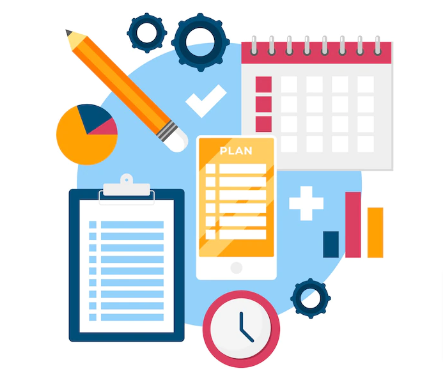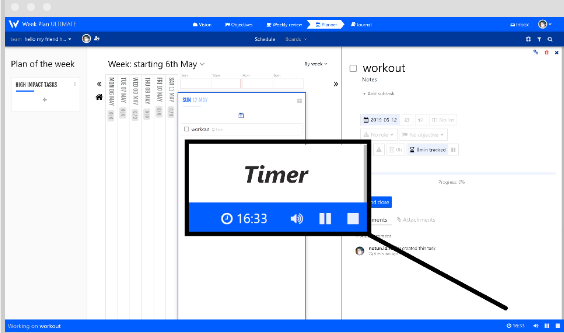6 Essential Things Your Productivity Planner Should Do for You
The Productivity Planner’s main concept is quality over quantity. It is designed to support effective planning by helping you organize and prioritize your key chores, you will accomplish more of the work that matters instead of frequently working on various projects or finishing unimportant tasks.
You must prioritize your daily work tasks at the start of each day. Choose the most important task you must complete, a few secondary chores, and things that would be good to complete but are not crucial.
1.What are productivity planners?
Whether or not we realize it, we all have a productivity system. Perhaps you use a blank notepad. Post-it notes on the refrigerator or voice memos on your phone. In these uncertain times, a productivity planner, whether digital or analog, can be an essential strategy for managing productivity.

If you’re feeling overwhelmed and have multiple conflicting priorities competing for your attention but don’t want to lose track of the larger picture, having everything in one location can help. Planners are also helpful today because many teams operate remotely, making monitoring project progress and remembering meetings more challenging.
Productivity planners, also known as day planners or personal organizers, are a means to keep track of your team’s schedules, activities, projects, and goals. A daily planner is a specific type designed for detailed daily scheduling, often featuring hourly breakdowns and compact sizes for everyday use. Since the 1980s, when the stylish ring-binder files had a calendar, contacts, task list, and blank pages for notes, they have gone a long way, evolving into various formats to suit different organizational needs.
Many software tools and mobile applications currently simulate the analog productivity planner. And these organizational tools might be essential for keeping your teams and projects on schedule.
Nevertheless, despite the sophistication of today’s digital productivity tools, paper planners, ranging from bullet journals to the humble diary, continue to be popular. The selection of available planners includes options for students, teachers, entrepreneurs, families, and more, highlighting their versatility and broad appeal. Why is this the case, and how might modern digital productivity planners supplement them?
Did you know? Gustav Grossmann invented the productivity planner in the 1930s, claiming that it helped individuals boost their productivity and lead “logical” lifestyles when used in line with his enclosed instructions.
2. What methodology supports the productivity planner?
What distinguishes a productivity planner from a to-do list on which anyone can jot down things and check them off? The answer is that it is an approach that, if adopted, can aid in habit maintenance and help you hit your target achievement.
However, to adopt this practice, you must locate a productivity planner that meets your company’s needs.
3. Why use a productivity planner?
- A planner allows you to manage your schedule effectively. The perfect tool for organizing your day, a planner helps you arrange your schedule and keep track of your appointments with a planner. You can also scribble down reminders and important notes.
- A planner helps you get more done. The more you accomplish, the more time you have for things you enjoy.
- A planner helps in sustaining motivation. Using a planner, you may create objectives and inspire yourself to achieve them. Then, create a rewards system in which you can reward yourself with the required item if you achieve your goal.
List of 6 Essential Things Your Productivity Planner Should Do for You.
Let’s have a look at six essential items a productivity planner should do for you.
1. A productivity planner should have goals setting section for goals prioritization.
Goal setting is the cornerstone of productivity. It is a robust tool that can assist you in identifying the most important aspects of your life to prioritize them. Although we would like to do everything at all times, we cannot, and that’s okay.
Prioritizing and making time for the most important things will help you feel more productive and fulfilled. A successful goal-setting section in your productivity planner should be able to guide you through the entire process, from visualizing your goal to achieving it a reality, with these steps:
- Demonstrate why a goal is essential to you.
- Specify the endpoint of the goal (what it will look and feel like)
- Define bite-sized action steps to achieve your objective.
- Determine the resources you’ll require and the challenges you’ll have to overcome to achieve the task.
- A time tracker that allows you to monitor your progress
- To stay motivated to achieve your goal’s finish line, offering completion rewards (optional) is essential.
Goal-setting is an opportunity to envision your ideal life and take action to achieve it. This should be an integral part of your productivity planner.
Pro Tip: You can prioritize your goals using the quadrant view, also called the Eisenhower quadrant of Week plan. This tool will assist you in prioritizing your goals and objectives. You can set many objectives for each workspace, project, company, or team.
2. A productivity planner should have a time blocking and time tracking feature.
We firmly believe that the easiest and most effective approach to increase your productivity is to track your time for a week. If you don’t know how you spend your time, you won’t understand how long it takes you to finish tasks (hint: it’s longer than you think).
Time blocking allows you to better plan and manages your time after you have tracked your time. Time blocking is the process of determining what you will complete in discrete blocks of time throughout the day. Next, determine the optimal duration for your time blocks; for how long can you generally remain focused?
Then, decide what you wish to do throughout that period. Tracking your time can help you be realistic about what you can do during your time block, allowing you to remain motivated and focused without being overwhelmed.

Pro Tip: The Week plan’s time tracking feature provides a detailed view of the time required to finish work and its associated subtasks. You can set a timer for tasks, goals, and group projects.
3. A productivity planner should help you manage and organize projects, tasks, and ideas.
When attempting to concentrate, one of your issues is a racing mind. Or you’re trying to complete one task while discovering five more that need to be done. But you’re trying to focus. So, what should you do?
If you’re anything like this, you need a place to write down and arrange all of your thoughts. Then you may return to them when I’m ready to tackle or explore it further. Whatever you choose to call it… Whether you call it a mind sweep, an inbox, or a brain dump, the goal is to get everything out of your head, so it doesn’t take up the space you need to get things done.
4. A productivity planner should be flexible, so it functions as you require.
Flexibility may be the most challenging trait to discover in a planner. On some days, you may only need a weekly overview to work from, while on others, you may have a million things going on and require the room of a daily layout to write them all down. If you’re stuck in this situation, you require a weekly and daily layout each week.
No two days are the same; if the last two years have taught you anything, things may shift quickly and dramatically. Therefore, you require a planner to adapt to your changing needs to maximize productivity.
In our opinion, the problem with most planners is that you are limited to a single layout for an extended time. And you will not know if it will work for you until you have used it for more than a day. As a result, you would spend a lot of money seeking a planner calm and ideal planner. But a single planner layout cannot accommodate all your needs, as they vary daily and seasonally.
Pro tip: Week plan has different categories of planners according to your needs. It has daily, weekly, and monthly planners that have different features. Besides this, you can boost your performance, achieve creativity and reduce your stress level by using this exciting productivity planner app.
5. A productivity planner should encourage self-reflection so that you can learn and improve!
Reflecting on what worked and what did not is one of the most important exercises for improving productivity. Unfortunately, some days/weeks are so hectic that we lack time to stop and reflect. However, taking the time to engage in this simple reflection can help you improve your life.
These are the questions for reflection:
- What work?
- What didn’t work?
- What steps can I take to improve (tomorrow/next week/next month)?
Pro Tip: Focus planner of Week plan helps determine productivity’s true meaning. It is designed to help you take control of your life (both professional and personal) so that you can accomplish all the important happenings in your life.
6. A productivity planner should have a gratitude list to make you feel grateful daily.
Professor of psychology Robert Emmons’s research reveals that taking a few minutes each day to jot down three things for which you are grateful can tremendously affect your state of mind and the way you experience life. Consistently practicing this technique can promote positive emotions, raise life satisfaction, reduce depression, and increase general well-being.
When you begin going through the checklist or daily/weekly review in your productivity planner, you can use it as a gratitude diary in which you list three things you are grateful for each day.
The Bottom Line
Your art is your life. Every day is an opportunity to build something unique. Knowing and employing the building blocks of productivity will position you for success regardless of the planner or “brush” you use.
Remember that the productivity planner is intended to track your work and time, indicating that you are responsible for what happens inside your planner.
As you experiment with several planners, you will focus on the optimal one and speed up your route to leaving a mark on the universe.
We suggest you check out Week plan, a reliable digital planner. It is a productivity planner that will help to increase your productivity, enables you to prioritize your goals, achieve your objectives and track your time with a consistent approach.

More Posts
10 Top Digital Planner Trends and Innovations
![weekplan]() Digital planners have revolutionized our daily to-do lists, making it easier than ever to organize our busy lives. But what's next for this technological marvel? Dive in as we explore the 10...
How WeekPlan helps you implement OKR in less time?
Are you are tired of complicated OKR software? Are you on the hunt for a software that can aid you implement OKR in a matter of minutes? If yes, then you are in...
10 Useful Skills You Can Learn In Less Than a Week
In today's fast-changing world, learning quickly is key for growing personally and improving yourself. Josh Kaufman, a business expert, says you can learn a new skill in just 20 hours. You can break...
3 Productivity Tips to Do More in Less Time
This article will discuss 3 productivity tips that will help you get more done in less time. Why is that important? Or let me ask a better question. Why is productivity important? We...